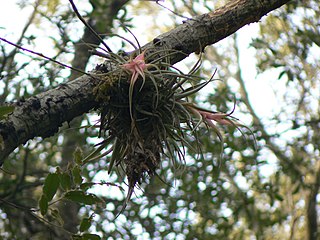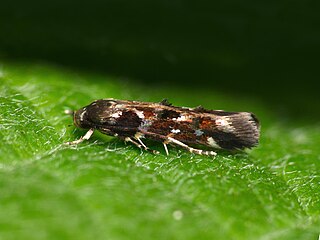
The Circaea, or enchanter's nightshades, are a genus of flowering plants in the evening primrose family Onagraceae. About two dozen taxa have been described, including eight species. Plants of the genus occur throughout the temperate and boreal forests of the Northern Hemisphere. Three taxa occur in North America: Circaea alpina, Circaea canadensis, and the hybrid Circaea × sterilis. The generic name Circaea refers to the enchantress Circe from Greek mythology who is said to have used the herb as a charm.

Lophospermum is a genus of herbaceous perennial climbers or scramblers, native to mountainous regions of Mexico and Guatemala. Those that climb use twining leaf stalks. Their flowers are tubular, in shades of red, violet and purple, the larger flowers being pollinated by hummingbirds. Now placed in the greatly expanded family Plantaginaceae, the genus was traditionally placed in the Scrophulariaceae. The close relationship with some other genera, particularly Maurandya and Rhodochiton, has led to confusion over the names of some species.

Circaea lutetiana, known as broad-leaved enchanter's nightshade, is a plant in the evening primrose family, Onagraceae.

Theretra japonica is a moth of the family Sphingidae first described by Jean Baptiste Boisduval in 1869.

Tillandsia erubescens is a species of epiphytic plants of the genus Tillandsia. This species is endemic to Mexico, found over much of the country from Chihuahua to Oaxaca.

Olearia erubescens, commonly known as moth daisy-bush or pink-tip daisy-bush, is a species of flowering plant in the family Asteraceae. It is a shrub with stiff, prickly leaves and white "daisy" flowers, growing up to 2 metres high.

Mompha terminella is a moth in the family Momphidae found in Europe and North America.

Lophospermum erubescens, known as Mexican twist or creeping gloxinia, is a climbing or sprawling herbaceous perennial plant, native to the Sierra Madre Oriental mountains of Mexico, where it is found along forest margins or canyon walls. It climbs by means of twining leaf stalks. Wild plants have pink and white tubular flowers, although other colours are found in cultivation. It has been cultivated as an ornamental plant since at least 1830. Although not frost-hardy, it will survive if its base and roots are protected from freezing in the winter. It has escaped from cultivation and become naturalized in tropical and subtropical areas of the world.

Circaea alpina, commonly called alpine enchanter's nightshade, small enchanter's nightshade, or dwarf enchanter's nightshade is a 10–30 cm tall perennial herb found in cool forests of the Northern Hemisphere.

Metatropis rufescens is a species of true bugs. The species is found in Europe, with the exception of the far North and South then East to the Black Sea region and across the Palearctic to Siberia. In Central Europe it is common, but it is not found everywhere. In the British Isles it is common in the South including Wales and Ireland. It occurs in shady, mostly moist habitats in deciduous forests.

Circaea canadensis, known as eastern enchanter's nightshade, Canada enchanter's nightshade, broad-leaved enchanter's nightshade, is a perennial herbaceous plant found in forests of eastern North America. It is very similar to its sister species, Circaea lutetiana, and was formerly considered conspecific.
Circaea × intermedia is a hybrid of flowering plants in the evening primrose family Onagraceae. The parents of the hybrid are Circaea alpina and Circaea lutetiana.

Viburnum erubescens, the reddish viburnum, is a species of flowering plant in the family Viburnaceae. It is native to Sri Lanka, India, Nepal, Bangladesh, China, Myanmar, and Vietnam. It is a deciduous shrub that grows in forests and scrub. Flowers are fragrant and bloom April to June. The unimproved species is available from commercial suppliers, as is a putative variety, Viburnum erubescens var. gracilipes, the slender blushing viburnum, and a number of cultivars, including 'Foster', 'Lloyd Kenyon', 'Milke Danda', and 'Ward van Teylingen'.
Circaea × sterilis is a hybrid of flowering plants in the evening primrose family Onagraceae. The parents of the hybrid are Circaea alpina and Circaea canadensis.
Circaea × decipiens is a hybrid of flowering plants in the evening primrose family Onagraceae. The parents of the hybrid are Circaea erubescens and Circaea canadensis subsp. quadrisulcata.
Circaea × mentiens is a hybrid of flowering plants in the evening primrose family Onagraceae. The parents of the hybrid are Circaea alpina and Circaea erubescens.
Circaea × skvortsovii is a hybrid of flowering plants in the evening primrose family Onagraceae. The parents of the hybrid are Circaea cordata and Circaea canadensis subsp. quadrisulcata.
Circaea × ovata is a hybrid of flowering plants in the evening primrose family Onagraceae. The parents of the hybrid are Circaea cordata and Circaea mollis.
Circaea × dubia is a hybrid of flowering plants in the evening primrose family Onagraceae. The parents of the hybrid are Circaea cordata and Circaea erubescens.
Circaea × taronensis is a hybrid of flowering plants in the evening primrose family Onagraceae. The parents of the hybrid are Circaea alpina subsp. imaicola and Circaea cordata.











